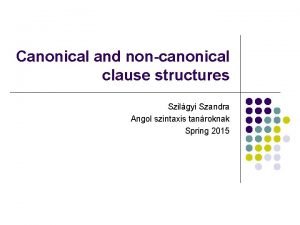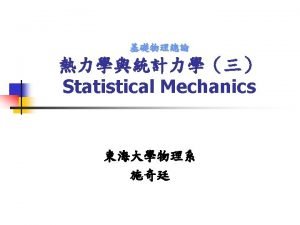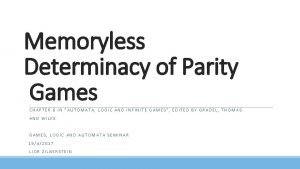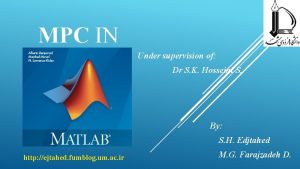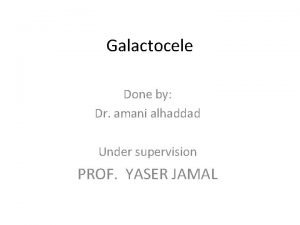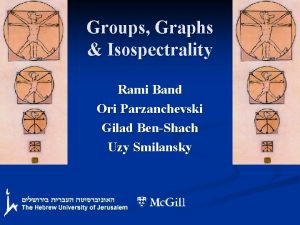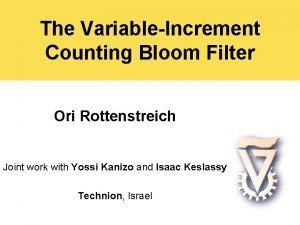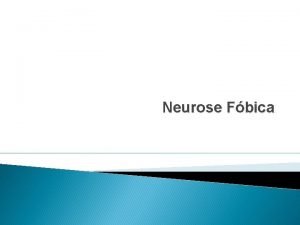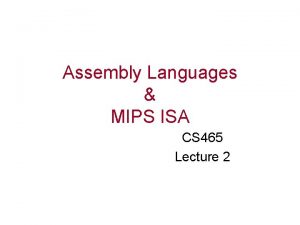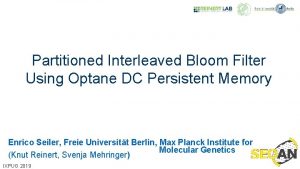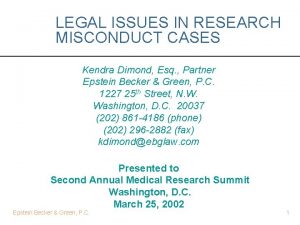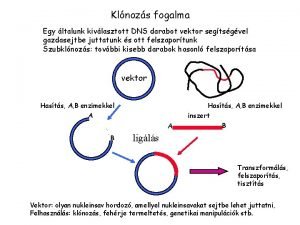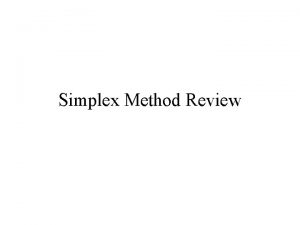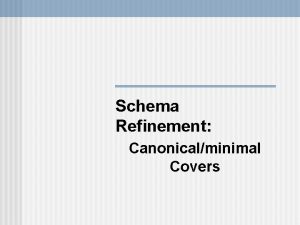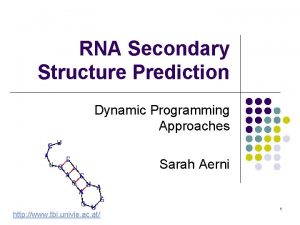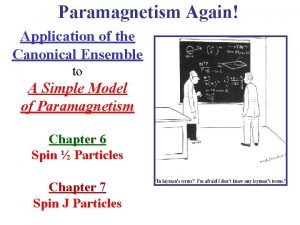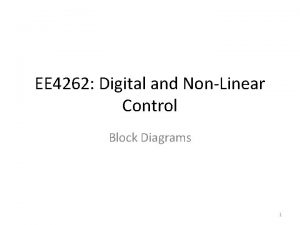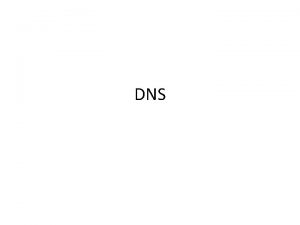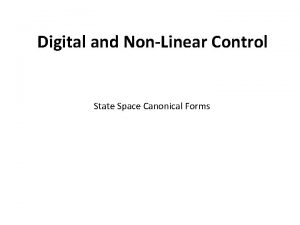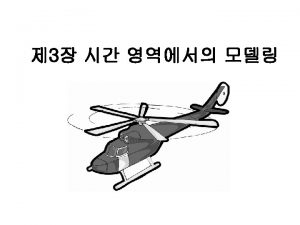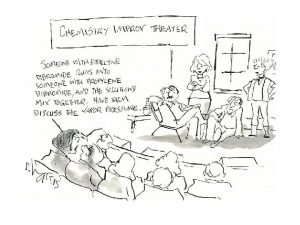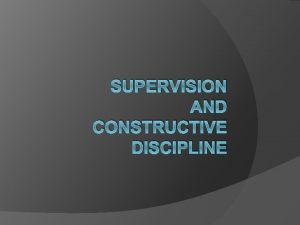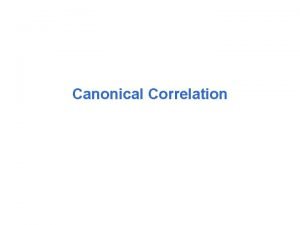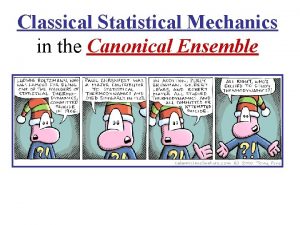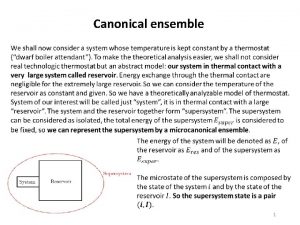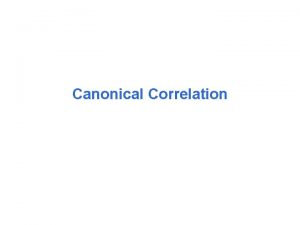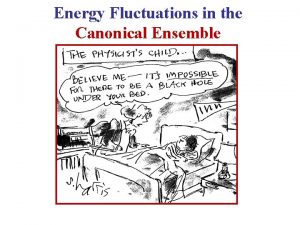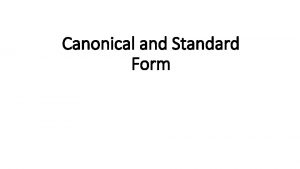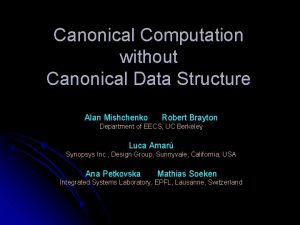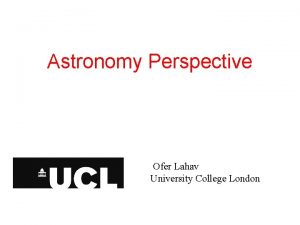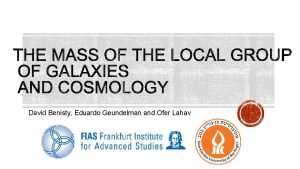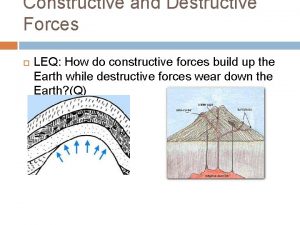Canonical Constructive Systems Ori Lahav under the supervision

































- Slides: 33

Canonical Constructive Systems Ori Lahav under the supervision of Prof. Arnon Avron 28 July 2009

The Problem What is a constructive connective? Our Approach Proof-theoretically, a constructive connective is defined by a set of canonical logical rules in single-conclusion cut-free Gentzen systems. We identify the largest family of connectives that can be characterized in this way, and provide Kripke-style semantics for this family. 2

Strict vs. Non-Strict sequential system Non-strict sequential system Only definite sequents (sequents of the form ) are used in derivations. Also negative sequents (sequents of the form ) are used in derivations. � The strict version is more natural to induce an tcr. � Gentzen’s original single-conclusion sequential system (LJ) was non-strict. � Previous papers (Bowen 71, Kaminsky 88 and Ciabattoni and Terui 06) consider non-strict systems. � We begin this presentation with the strict version, and postpone the non -strict case. 3

Example: Strict Canonical Rules for Implication Rule Introduction p 1 p 2 / p 1 p 2 Elimination p 1 p 2 / p 1 p 2 Application 4

Definition: Strict Canonical Rule �A strict canonical introduction rule of ◊ is an expression of the form: 1 q 1 , …, m qm / ◊(p 1, …, pn) where i qi are definite Horn-clauses over p 1, …, pn. �To use this rule: ◦ Choose a substitution . ◦ Choose left context . ◦ Apply the rule: , ( 1) (q 1) … , ( m) (qm) (◊(p 1, …, pn)) 5

Definition: Strict Canonical Rule �A strict canonical elimination rule of ◊ is an expression of the form: 1 q 1 , …, m qm, 1 , …, k / ◊(p 1, …, pn) where i qi and i are Horn clauses over p 1, …, pn. �To ◦ ◦ use this rule: Choose a substitution . Choose left context . Choose right context . Apply the rule: , ( 1) (q 1) … , ( m) (qm) , ( 1) … , ( k) , (◊(p 1, …, pn)) 6

Example: Strict Canonical Rules for Gurevich's “Semi-Implication” Rule Introduction p 2 / p 1 p 2 Elimination p 1 p 2 / p 1 p 2 Application 7

Strict Canonical (Single-Conclusion) Systems • Axioms Structural Rules Logical Rules • Cut , , Weakening , • Strict Canonical Introduction and Elimination Rules 8

Consistency of a Canonical System �A canonical system is called consistent (or non-trivial) iff we cannot prove p 1 p 2 in it. �Example: “Tonk” [Prior] �Question: Can we find a simple criterion for consistency of strict canonical systems? �An answer to this question in the multipleconclusion framework is that the system should be coherent [Avron Lev 01, 05]. 9

Coherence of Canonical Systems �A set of canonical rules for ◊ is called coherent iff whenever it includes both S 1 / ◊(p 1, …, pn) and S 2 / ◊(p 1, …, pn) then S 1 S 2 is classically inconsistent. 10

Examples: Coherence �Implication: p 1 p 2 / p 1 p 2 �Semi-Implication: p 2 coheren t p 2 / p 1 p 2 / p 1 p 2 coheren t 11

Examples: Coherence �“Tonk”: p 2 / p 1 T p 2 p 1 / p 1 T p 2 �This p 1 NOT coheren t is what is wrong with “Tonk”. 12

Coherence and Consistency �Theorem: Coherence is necessary and sufficient for consistency of strict canonical system. �A strict canonical system is called constructive iff every connective has a coherent set of rules. 13

Cut Elimination in Canonical Systems �Cut Elimination Whenever s is provable (without assumptions), then there exists a cut-free proof of s. �Strong Cut Elimination Whenever s is provable from a set of sequents R, then there exists a proof of s from R, in which the only cuts used are on formulas (not subformulas!) from R. 14

Semantics A Generalized (Kripke) Frame is a triple W = W , < , v where: ◦ W , < is a nonempty partially ordered set. ◦ v: W wffs { t , f } is a persistent function. (i. e. if v(a, )=t then for every b≥a v(b, )=t). 15

Semantics Let W = W , < , v be a generalized frame: ◦ A sequent is locally true in a W if either v(a, )=f for some , or v(a, )=t for some . ◦ A sequent is true in a W if it is locally true in every b ≥ a. ◦ W is a model of a sequent if it is locally true in every a W. 16

Semantics Let G be a strict canonical constructive system. A generalized frame is G-legal iff it respects its rules: Respect Strict Introduction Rules • The conclusion is locally true in a, whenever the premises are true in a. Respect Strict Elimination Rules • The conclusion is locally true in a, whenever the definite premises are true in a and the negative premises are locally true in a. 17

Example: Semantics of Implication p 1 p 2 / p 1 p 2 v(a, )=t if v(b, )=f or v(b, )=t for every b ≥ a v(a, )=f if v(a, )=t and v(a, )=f exactly the well-known Kripke semantics for intuitionistic implication. 18

Example: Semantics of “Semi. Implication” p 2 / p 1 p 2 / p 1 p 2 v(a, )=t if v(a, )=t v(a, )=f if v(a, )=t and v(a, )=f Free when v(a, )=f and there is no b≥a such that v(b, )=t and v(b, )=f. Non-deterministic semantics. 19

Main Results �Strong Soundness and Completeness: A sequent s is provable from a set of sequents R in G iff every G-legal generalized frame which is a model of R is also a model of s. 20

Main Results �General Strong Cut Elimination: Every strict canonical constructive system admits strong cut-elimination. �Decidability: Every strict canonical constructive system is decidable. �Modularity: The characterization of a constructive connective is independent of the system in which it is included. 21

Corollary Consistenc y Cut Elimination Coherence Strong Cut Elimination Equivalences for Strict Canonical Systems 22

Definition: Non-Strict Canonical Rule �A non-strict canonical introduction rule of ◊ is an expression of the form: 1 E 1 , …, m Em / ◊(p 1, …, pn) where i Ei are definite Horn-clauses over p 1, …, pn. �To use this rule: ◦ Choose a substitution . ◦ Choose left context . ◦ Apply the rule: , ( 1) (E 1) … , ( m) (Em) (◊(p 1, …, pn)) 23

Definition: Non-Strict Canonical Rule �A non-strict canonical elimination rule of ◊ is an expression of the form: { 1 E 1 , …, m Em } , { 1 , …, k } / ◊(p 1, …, pn) where i Ei and i are Horn clauses over p 1, …, �To ◦ ◦ use this rule: p n. Choose a substitution . Choose left context . Choose right context E. Apply the rule: , ( 1) (E 1) … , ( m) (Em) , ( 1) E … , ( k) E , (◊(p 1, …, pn)) E 24

Example: Non-Strict Canonical Rules for Negation Rule Introduction p 1 / p 1 Elimination { p 1 } , { } / p 1 Application 25

Example: Non-Strict Canonical Rules for Bowen’s “Not-Both” Rule Introduction Elimination Application p 1 / p 1|p 2 { p 1 , p 2 } , { } / p 1|p 2 26

Non-Strict Canonical Systems • Axioms Structural Rules Logical Rules • Cut , E Weakening E , E • Non-Strict Canonical Introduction and Elimination Rules 27

Semantics Let G be a non-strict canonical constructive system. A generalized frame is G-legal iff it respects its rules: Respect Non. Strict Introduction Rules • The conclusion is locally true in a, whenever the premises are true in a. Respect Non. Strict Elimination Rules • The conclusion is locally true in a, whenever the definite hard premises are true in a and the negative soft premises are locally true in a. 28

Example: Semantics of “Not-Both” p 1 / p 1|p 2 { p 1 , p 2 } , { } / p 1|p 2 v(a, | )=t if v(b, )=f for every b ≥ a v(a, | )=f if v(b, )=t and v(b, )=t for some b ≥ a Free in cases like: Nondeterministic semantics. 29

Main Results �Strong Soundness and Completeness �General Strong Cut Elimination �Decidability Consistency �The previous equivalences ( ) do not hold. Cut Elimination Coherence Strong Cut Elimination 30

The Previous Equivalences Do Not Hold Rule Application Introduction p 1 / o p 1 Elimination { } , { p 1 } / o p 1 �Not coherent �Consistent �Admits cut-elimination �Does not admit strong cut-elimination 31

Strong Consistency of a Canonical System �A canonical system is called strongly consistent iff we cannot prove the empty sequent ( ) from p 1 and p 2 in it. Equivalences for Non. Strict Canonical Systems Strong Consistenc y Coherenc e Strong Cut Elimination 32

Finally, �A constructive connective is a connective defined by a set of rules in some canonical constructive system. �A constructive connective is defined by a coherent set of rules. 33
 Canonical clause definition
Canonical clause definition Ensemble grand n
Ensemble grand n Constructive proof vs non constructive
Constructive proof vs non constructive Constructive proof vs non constructive
Constructive proof vs non constructive Constructive proof vs non constructive
Constructive proof vs non constructive Constructive proof vs non constructive
Constructive proof vs non constructive Under supervision of prof
Under supervision of prof Under the supervision of dr
Under the supervision of dr Under the supervision of dr
Under the supervision of dr Galactocele areola
Galactocele areola Ori ben yehuda
Ori ben yehuda Ori parzanchevski
Ori parzanchevski Agrisnet.ori.nic
Agrisnet.ori.nic Www agrisnetodisha ori nic in l
Www agrisnetodisha ori nic in l Ori rottenstreich
Ori rottenstreich Ori keamanan significado
Ori keamanan significado Ti dao si nam čvrstu riječ daj nam svima duha svog
Ti dao si nam čvrstu riječ daj nam svima duha svog Ori rottenstreich
Ori rottenstreich Xra instruction in 8085
Xra instruction in 8085 Ori rottenstreich
Ori rottenstreich Lui mips
Lui mips Ori rottenstreich
Ori rottenstreich Ori research misconduct
Ori research misconduct Plazmid
Plazmid Isuse tu ne-ai chemat
Isuse tu ne-ai chemat Simplex
Simplex Canonical cover example
Canonical cover example Rna secondary structure dynamic programming
Rna secondary structure dynamic programming Application of canonical ensemble
Application of canonical ensemble Pickoff point
Pickoff point Canonical name in dns
Canonical name in dns Canonical observable form
Canonical observable form Grb 060614
Grb 060614 Canonical equation of motion
Canonical equation of motion
